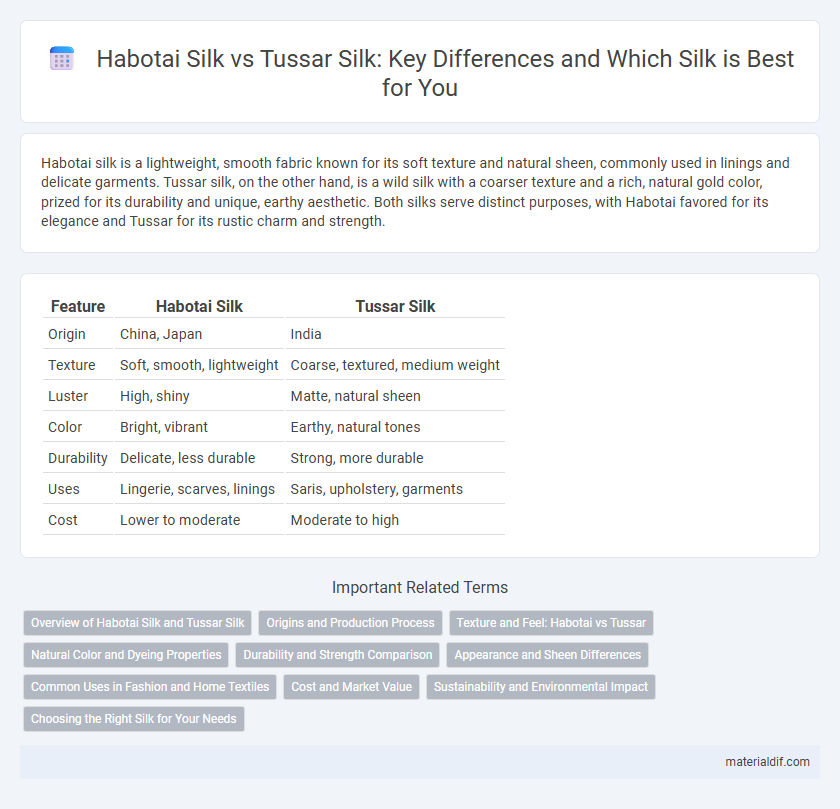Habotai silk is a lightweight, smooth fabric known for its soft texture and natural sheen, commonly used in linings and delicate garments. Tussar silk, on the other hand, is a wild silk with a coarser texture and a rich, natural gold color, prized for its durability and unique, earthy aesthetic. Both silks serve distinct purposes, with Habotai favored for its elegance and Tussar for its rustic charm and strength.
Table of Comparison
| Feature | Habotai Silk | Tussar Silk |
|---|---|---|
| Origin | China, Japan | India |
| Texture | Soft, smooth, lightweight | Coarse, textured, medium weight |
| Luster | High, shiny | Matte, natural sheen |
| Color | Bright, vibrant | Earthy, natural tones |
| Durability | Delicate, less durable | Strong, more durable |
| Uses | Lingerie, scarves, linings | Saris, upholstery, garments |
| Cost | Lower to moderate | Moderate to high |
Overview of Habotai Silk and Tussar Silk
Habotai silk, known for its smooth texture and lightweight feel, is primarily produced from cultivated Bombyx mori silkworms and is widely used in luxury linings and delicate garments. Tussar silk, derived from wild silkworms of the Antheraea genus, features a coarser texture with natural golden hues, valued for its durability and rustic aesthetic in traditional Indian textiles. Both silks differ significantly in fiber origin, texture, and typical applications, reflecting their unique production processes and cultural significance.
Origins and Production Process
Habotai silk originates from China and is produced using the cultivated Bombyx mori silkworm, known for its fine, smooth, and lightweight fabric favored in luxury garments and linings. Tussar silk comes primarily from India and is created by wild silkworms living on oak and other trees, yielding a coarser texture with natural golden hues prized for ethnic wear and upholstery. The production process of Habotai involves controlled sericulture with mulberry leaves as feed, resulting in uniform threads, while Tussar silk harvesting involves collecting wild cocoons, causing irregularities that enhance its rustic appeal.
Texture and Feel: Habotai vs Tussar
Habotai silk features a smooth, lightweight texture with a soft, satiny feel, making it ideal for delicate garments and linings. Tussar silk, on the other hand, exhibits a coarser, more textured surface with a natural, nubby feel due to its wild silk fibers. The lustrous sheen of Habotai contrasts with the matte, rustic appearance of Tussar, influencing the tactile experience and overall aesthetic.
Natural Color and Dyeing Properties
Habotai silk is known for its smooth texture and excellent dye absorption, resulting in vibrant, even colors, while retaining a natural lustrous white base that enhances color brightness. Tussar silk, naturally golden or beige, possesses a textured surface that absorbs dyes differently, often producing earthy and muted tones due to its coarse fibers and natural color variations. Both silks offer distinct natural hues and dye interaction, influencing their use in various textile applications.
Durability and Strength Comparison
Habotai silk, known for its lightweight and smooth texture, offers moderate durability and strength suitable for delicate garments and linings. Tussar silk, derived from wild silkworms, boasts greater tensile strength and natural resilience, making it more durable and ideal for heavy-use textiles and upholstery. The increased fiber robustness of Tussar silk results in superior longevity compared to the finer, more delicate Habotai silk.
Appearance and Sheen Differences
Habotai silk features a smooth, fine texture with a soft, lightweight feel and a lustrous, glossy sheen that reflects light evenly, highlighting its luxurious appearance. Tussar silk, derived from wild silkworms, has a coarser texture with a matte finish and natural gold or tan hues, giving it a rustic and earthy look. The sheen of Tussar silk is less reflective compared to the bright gloss of Habotai, emphasizing its organic, textured surface.
Common Uses in Fashion and Home Textiles
Habotai silk, known for its smooth texture and lightweight feel, is commonly used in fashion for making delicate garments like scarves, blouses, and linings, as well as in home textiles such as luxurious bedding and decorative pillow covers. Tussar silk, characterized by its rich texture and natural golden sheen, finds frequent use in ethnic wear, sarees, and upholstery, lending a rustic yet elegant touch to both apparel and home decor. The distinctive qualities of Habotai and Tussar silk determine their preferred applications, with Habotai favored for lightweight fashion and soft home linens, while Tussar is prized for its durability and unique aesthetic in traditional clothing and home furnishings.
Cost and Market Value
Habotai silk is generally more affordable due to its lightweight, smooth texture, and mass production primarily in China and Japan, making it widely accessible in the fashion and textile markets. Tussar silk, sourced mainly from wild silkworms in India, commands a higher market value because of its distinctive coarser texture, natural gold sheen, and labor-intensive production process. The premium price of Tussar silk reflects its rarity and cultural significance, attracting niche markets focused on luxury and ethnic textiles.
Sustainability and Environmental Impact
Habotai silk, derived from domesticated silkworms feeding on mulberry leaves, offers a more sustainable production process with lower environmental impact due to controlled farming and reduced chemical usage. In contrast, Tussar silk, sourced from wild silkworms feeding on various trees, often involves more extensive land use and chemical treatments, which can increase ecological disturbance. Habotai's eco-friendlier cultivation practices contribute to better biodiversity preservation and reduced water and energy consumption compared to the more variable Tussar silk production.
Choosing the Right Silk for Your Needs
Habotai silk, known for its lightweight, smooth texture, and affordability, is ideal for delicate garments, linings, and scarves requiring softness and drape. Tussar silk, characterized by its rich texture, natural gold sheen, and durability, suits upholstery, heavier garments, and traditional attire demanding a rustic yet elegant appearance. Evaluating factors like fabric weight, sheen, texture, and use case ensures selecting the right silk aligns with both aesthetic and functional requirements.
Habotai silk vs Tussar silk Infographic

 materialdif.com
materialdif.com